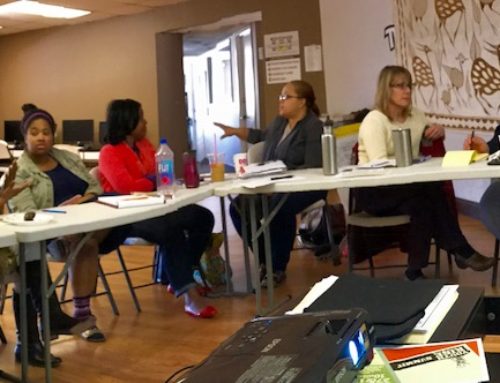This pamphlet is a useful set of guidelines for parents to use for effectively engaging with their child’s school. It is written in easy to read plain English without a bunch of educational jargon. The overarching idea of the handbook is that parents want their children to attend the most effective school they can. The most effective schools are those in which the entire community plays its role in the education of the children in the community. That means that the teacher, the students, the parents, the administrators, the school support staff, the central office personnel, the business owners, the faith-based leaders, the politicians, the community activists, and others work together for the good of the children in the school. The most effective schools are those in which this happens. Does that mean that every one of these stakeholders has to agree with or even like one another? No. Does it mean that every one of the stakeholders has to be of the same political or religious affiliation? No. But what it does mean is that at the end of the day all of those differences are secondary to making the best decisions for the education of the children in the community. The most dysfunctional schools or the schools that are the least successful are those where the stakeholders work against each other to the detriment of the students. Those schools never get to the needs of the students because the stakeholders cannot move beyond their differences. Those kinds of challenges are addressed through educational leadership-a topic for another day. This handbook’s focus is on the role of parents and families as stakeholders in the education of their children.
Parents and guardians as stakeholders have a responsibility to help their child’s school. But, many do not know how to effectively engage the school. The African proverb: “it takes a village to raise a child” is often used in discussions about creating better schools and communities for children. The problem with applying the proverb is that in many instances the members of the village do not know what their roles are or how to fulfill them. This handbook is designed to provide some guidance to parents on how to fulfill their role and how to actively and effectively engage their child’s school in order to make it the best school it can be. This pamphlet is by no means an exhaustive study and “cure all” for the challenges parents face in striving to get the best education for their children. Rather, it is a starting point, a set of guiding principles and actions that empowers parents and guardians in aiding their children.
There are seven basic guiding principles and practices discussed in this pamphlet. First and foremost be present. Show up for something to support your child and the school. Second, the interest of the child must be the focus of engagement with the school. Third, it is about family engagement which includes both parents and extended family members. Fourth encourage and support your child in extracurricular activities. Fifth, be an ally with your child’s teachers. Sixth, be actively involved in what your child is learning throughout their educational careers. Help with homework and projects. Seventh, join the PTA/PTSA and pay your dues. There is power in numbers. If you follow these guiding principles and practices will you never have problems with your child in school? Chances are, you probably will. This handbook is not meant to eliminate all of the problems that your child may have in school. However, if you follow these guidelines the resolution to the problems will be the best for your child and that is what we are all working towards-the best for our children!
Step 1: Be Present
The whole idea of parent/family and school engagement is about being present. Being present does not mean that you have to sacrifice your life and attend every school function. The key to effective school engagement is for you to know the people in the school who are working with your child and for them to know you. So, attend the back-to-school night and show up on parent conference day (especially if requested) but also arrange a class a visit or eat lunch with your child. Attend sporting events, chaperone field trips and other activities. Again, you do not have to be that “super” parent but it is certainly helpful and appreciated by the teachers and staff when there are extra adults around to help. Further, when you are present you get to know the adults and other children your child interacts with. They too will also get the opportunity to learn about you and your family. It is during theses informal meetings that the intangibles about what you expect for your child and from your child are communicated to the school community.
By getting to know the adults in the school and giving them the chance to know you when a problem does arise the resolution will more likely be favorable. A different tone is set when you are engaged with the school and an issue arises than when the only interaction you have with the school is when there is an issue. Do not think that the school can do it all. The more help you provide the better your child’s school will be and the more your child will learn.
Step 2: Keep Your Child’s Interests First
In your dealings with school personnel always maintain an attitude that reflects that you want the best for your child and the other children in the school. In our conversations with school personnel it becomes easy to forget that the people we are talking to want the best for our children just like we do. This can create disunity and conflict especially if parents are not engaged with the school. Remember that teachers, administrators, and support staff are people before they are anything else. You may want them to behave as “teachers,” “administrators,” “secretaries,” etc. according to how you think they “should” behave or respond. As parents we often deal with schools as working for us and have the expectation that we should always get what we want. Sometimes what we want as parents may not be in the best interest of our child, particularly when the interests of the child is not the focus of the engagement.
Once you have created a presence at the school at whatever level fits your capabilities make sure that your engagement with the school focuses on your child’s interests. Whether you have a concern about something happening with the child’s teacher or commenting at a PTA meeting make sure that your child is the real focus. As humans we can easily allow our personal likes and dislikes to interfere with our goals. When we allow this to happen the child’s education suffers and everyone loses. When both sides “dig in” to their positions dysfunction is created leaving no room for an amicable solution instead of parent and professional educator working together for the best interest of the child/student. The result is there are two adults whose focus has shifted away from the child and the discussion is really about them and their perceptions of one another. This is not to say there will not be any conflict. But it is more likely that a positive outcome will be the result if you follow this plan. Even if you do not get what you think is best and you have to seek assistance elsewhere the focus has always been on the best interest of your child and you have maintained a positive relationship with the school.
Step 3: Engage Parents and “FAMILY”
Involve as many family members as possible with your child’s education. In today’s society parents have so many responsibilities that being engaged with the school can be challenging. That is why it is important to have a group of family members who support one another in their children’s education. Of course, with major issues and most important things parents must be involved. However, there are other ways that families can support their children. Be your child’s publicist. Do not just involve immediate family members but include extended family members and friends in invitations to events and programs at your child’s school. If your daughter runs track or is on the debate team make sure everyone you know has a copy of the schedule. They may not be able to go when you do but they can go at their convenience. Think of everyone in the community as family in this regard even if they do not have children.Watch Full Movie Online Streaming Online and Download
Think of yourself as not only a publicist for your child but also as a publicist for the school. You may know someone in the neighborhood that enjoys theater and your child is in the school play. Let that person know about the performance. Even if they do not attend they will think of the school in a positive light and see its value as serving the community. Simply put, bring as many people as possible to your child’s school to support them and the school. Your child will feel empowered by knowing that the community supports their efforts. It does wonders for a child when they see adults from their neighborhood that they may only know by face showing up at their school, especially in support of their endeavors. They begin to develop a sense of pride and importance. Even more importantly they become more respectful of the adults because they see the adults support as respect for them and what they do.
Step 4: Encourage Your Child to Participate in Extracurricular Activities
Encouraging your child to participate in extracurricular activities goes hand in hand with being present and including extended family in your child’s education. Extracurricular activities include more than just sports activities. All activities that take place beyond the normal school day are extracurricular. Being a member of a club, participating in a service learning or volunteer project, working at the concession stand during football games are all extracurricular activities. They are good for your children for a variety of reasons. First, they create non-academic connections between your child and the school. An emotional bond is created because extracurricular activities are based on what your child likes. Emotional connections are personal and meaningful. Thus, it follows that your child will be more vested in the school. So, encourage your child to participate in extracurricular activities based on their likes.
Extracurricular activities are also good because your child will get to meet a broader range of students from diverse backgrounds. Thus, their cultural awareness and understanding of others is expanded. They also get to know faculty and staff members that they do not normally interact with. More importantly, those faculty and staff members get to know your child as a person. It gives them an opportunity to appreciate their character. Finally, participation in extracurricular activities broadens your child’s “cultural diet” that will ultimately build their character and confidence.
Step 5: Ally and Empathize with Your Child’s Teachers
One of the most critical relationships in your child’s academic career is that between you and your child’s teachers. It is so vital to their success because the teacher is directly responsible for your child’s education. The teacher also has an awesome responsibility in evaluating and assessing your child’s level of achievement. The teacher has to determine how much or how little of what your child was supposed to learn they actually did learn. By developing a positive relationship with your child’s teachers you can help the teachers do the best job they can to assess their progress.download movie Madraza
One way to develop a good relationship is to not only let the teacher now what your expectations are from them for your child’s education but to also let the teacher now what you expect from your child. Teachers are always appreciative to know that their student’s parents hold their children to a high standard of behavior and academic rigor. By sending this message to the teacher you become allies in your child’s education working together to ensure their success.
To further ally yourself with your child’s teacher empathize with them and show your appreciation for their efforts. Teaching can be a lonely and thankless profession yet, it is arguably the most important role in society. Teachers are often overburdened and are constantly busy. There is always something to do. There never really is any free time. When opportunities present themselves to show appreciation for the very important service teachers provide to your child show it. Send a card on teacher appreciation day. Contribute to the teacher breakfast during American education week. A little bit of appreciation and empathy goes a very long way in developing a positive relationship.
Step 6: Help with Homework and Projects
Helping your child with homework assignments and projects builds a connection between you and what your child is learning. Being aware of what is being taught in your child’s class is essential to holding them accountable for their role in their education. If you know what your child is suppose to be doing it makes it easier for you to help them do it. Therefore, make sure you and your child know the purpose of all homework assignments. Homework is generally assigned for one of two reasons; to reinforce something that has already been taught or to introduce a new topic.film I Don’t Feel at Home in This World Anymore 2017 trailer movie streaming
Projects on the other hand are usually given as an assessment that allows students the opportunity to demonstrate what they have learned in a more creative way than a paper and pencil test. They are also used to provide students with the opportunity to do further investigation and enrichment. So, don’t do the project for your child. Instead, have them teach you what they have learned as they create their projects. By them teaching you it reinforces their learning and provides them with the opportunity to think about what they have learned in different ways.
One of the most frustrating things for teacher is to have a class where large numbers of students come without their homework. It creates a feeling of isolation and lack of support. By helping your child with projects and homework it supports your child and their teacher. One final note on homework and projects – do not stop supporting a child once they get to high school. Your child will need your help with homework and projects throughout their school career regardless of how good a student they may be or how old they get. The only thing that changes is the way you support your child. As they progress they should be given more responsibility and accountability while you must still ensure they know the purpose of their homework, know what they are responsible for learning and ensuring they have worked to their highest ability.
Step 7: Join the PTA/PTSA
One of the simplest ways to support your child’s education through school engagement is to join the PTA/PTSA. Joining the PTA/PTSA is helpful to your child’s education for two key reasons. First it provides the parents/families with the strength of a collective voice to share what you think about how the school is doing. Secondly, as a relatively independent body it has the opportunity to do things for the students and the school that the school may not be able to do because of legal restrictions or school policies. Further, as an independent body the PTA/PTSA can create their own programs and activities that the school does not or may not have the resources to implement.
Don’t be reluctant to join because you think you cannot be involved enough. Whatever you can offer will be greatly appreciated and helpful. There are basically three ways you can contribute to the PTA/PTSA. The easiest way to contribute is to become a dues paying member. Your financial contribution will help cover the costs of programs for the students. You can also support the PTA/PTSA by helping to plan events. It is not necessary to be involved in all of the events but choose something that matches your skills and likes. If you cannot help with the planning then show your support by participating or attending, especially if your child is involved. Finally, you can provide maximum support to your child’s school’s PTA/PTSA by running for an office and being an organizer. As you can see there are many levels of support you can offer based on your time and interests. The key is to have a strong group of parents to speak and act as a collective to support all the children in the school.watch Buena Vista Social Club: Adios 2017 movie now
movie Beauty and the Beast streaming






Leave A Comment